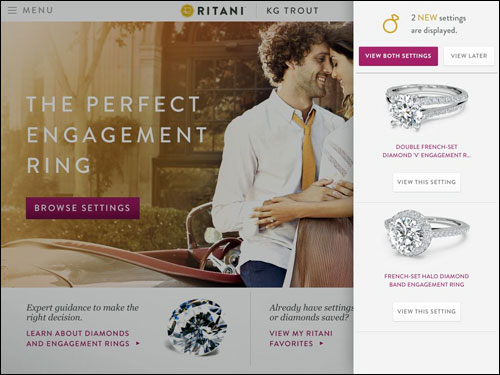Jun 03, 2014Ritani, a jewelry company based in Seattle, Wash., is preparing to launch a multistore pilot of a radio frequency identification solution enabling retailers that sell Ritani jewelry to automatically display information about merchandise that customers asked to see, and also allows those shoppers to share the items' images and descriptions with friends or family members prior to or after making a purchase. What's more, store management will be able to collect data regarding sales-floor behavior, including which items have been viewed, the percentage that were purchased and employees' sales rates.
The technology is intended to provide shoppers at brick-and-mortar stores with the advantages they can gain during online shopping—such as easy access to data about a product and the ability to scroll to similar items before making a purchase. The system, using EPC Gen 2 ultrahigh-frequency (UHF) passive RFID tags on jewelry, as well as readers built into displays, could be installed at any of the approximately 180 retailers that sell Ritani products, upon their request.
Ritani, a wholesaler of rings, pendants, earrings and other jewelry, specializes in custom-designed items. In 2012, the company opened its Ritani.com division, to sell its products to customers via a partnering retailer. A customer designs a piece of jewelry online, and is then directed to the nearest store to pick up that custom-made piece.
However, Ritani sought to create an experience that would encourage more shoppers to browse through goods at the store, in addition to ordering a product online. The company has approximately 180 participating stores, each with a Ritani-supplied display case—typically containing about 65 items per case—offering in-store customers the opportunity to try on an item and see how it looks. Shoppers often take a selfie of their hands while wearing jewelry and share the images with friends, says Mark Keeney, Ritani's marketing VP, though these are typically not high-quality pictures, and do not provide much information for the photos' recipients.
For the pilots, Ritani will install a UHF reader at the back of the case in which its products are displayed, and attach RFID tags to each jewelry item's existing price label. Keeney declined to indicate the specific company providing the readers or the tags, citing trade secrets.
Each jewelry tag will be encoded with a unique ID number that is stored in Ritani's software, residing on the company's server, where it will be linked with details regarding that item, such as its serial number and type, as well as related media—for instance, pictures, specifications and price. To access the server, the retailer would download a Ritani app on an iOS device, typically an Apple iPad.
If a customer asks to view a specific piece of jewelry, the salesperson will remove the item from the case and pass it within range of the reader. The interrogator will capture the tag's ID number and forward that information to the back-end server, which will then push the media to devices logged into the server via the app, such as an iPad used at that cabinet. In that way, a customer can automatically view the data on the tablet after being handed the piece of jewelry. The software also allows him or her to scroll through other items that are similar, and send the data to a friend's or family member's e-mail or social-media account, in order to get that person's opinion.
Although the technology's primary benefit will be to better engage with shoppers, and thereby increase jewelry sales, Keeney says, it will also provide other value to retailers. With the system in place, a store's managers will know when and how often a particular item was viewed, as well as whether it was then purchased. If a salesperson inputs an ID number, the system will also know that associate's sales performance.
The pilots are expected to begin during the next 30 to 60 days, Keeney reports. If they go well, he says, Ritani plans to offer the solution to all of its retailer partners, splitting installation costs with each retailer.
Ritani exhibited a prototype of the system at the Jewelers' Circular Keystone (JCK) trade show, held this week in Las Vegas. According to Keeney, the technology is being received at the event with a great deal of enthusiasm from retailers.



